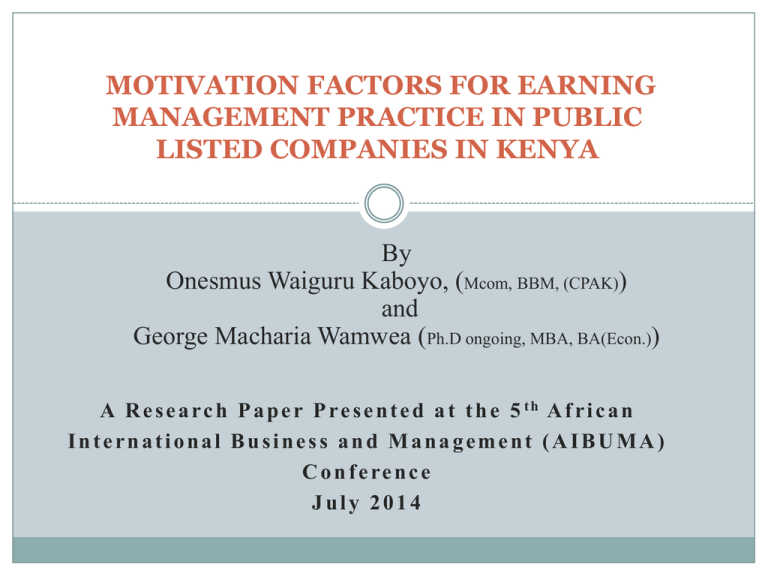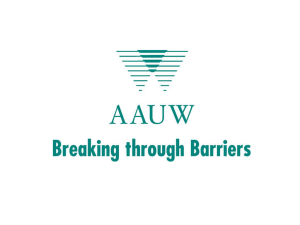Motivation Factors For Earning Management Practice In Public
advertisement

MOTIVATION FACTORS FOR EARNING MANAGEMENT PRACTICE IN PUBLIC LISTED COMPANIES IN KENYA By Onesmus Waiguru Kaboyo, (Mcom, BBM, (CPAK)) and George Macharia Wamwea (Ph.D ongoing, MBA, BA(Econ.)) A R e s e a rc h P a p e r P re s e n t e d a t t h e 5 th A f r i c a n International Business and Management (AIBUMA) Conference July 2014 Background Different academicians, researchers, practitioners and various authoritative institutions have different meanings and names over earnings management. Some refer to it as creative accounting (Catherine and Orial, 2005; Tiina and Linh, 2002), Others refer to it as corporate fraud. (Copeland, 1968), (Pravean Nisen, 2009) Lawrence (2009) calls it fraudulent financial reporting. As such a universally accepted meaning of the term earnings management is still a matter of academic debate. Background (continued) The rising issue of earning management fraud therefore fastens the need to define ‘earning management’. Earning management is normally discussed in relation with financial statements fraud. Financial statements fraud cases have described various methods of earning management used to commit fraud (Rezaee, 2002). include revenue recognition illegitimately, inappropriate deferral of expenses, fictition of sales and early sales, reversed or use of unjustified reserves Many accountants accept that some earnings management techniques are not fraudulent and that managers are there to manage earnings (Magrath and Weld, 2002). Background (continued) Jooste, (2011) argues that there is positive and negative side to earning management. The negative side is the misallocation of resources which is cost created the positive side is the potential in the development of management’s credible communication of private information to external stakeholders to improve resources allocation decisions. Background (continued) According to Hand (1990), earnings management is an opportunistic practice. This approach is based on the functional addiction hypothesis users of financial information are not able to correctly interpret and understand accounting numbers and accounting choices. In that case, earnings management can be seen as a way to mislead investors and other users of accounting figures, about the performance of the firm. Background (continued) The line that separates earning management and management fraud is too thin and managers are becoming reluctant to discuss the linking of these two concepts (Brown, 1999). Fraudulent reporting was first exposed after the United State of America great economic crash in 1929, then after Savings & Loans financial scandals in the 1980s and soon after the dot-com bubble of the early 1990s to 2000s (Robert,2011). The rising pressure to reduce fraudulent financial reporting over the years has resulted in new laws, commission reports and standards. Background (continued) The Global Economic Crime Survey (2011) targeting firms around the world found out that, 18% was done by senior executives, and 41% was done by middle level managers, 39% was done by junior staff members and 2% done by other employees. This expressed that middle level management and senior executives are the biggest fraudsters Problem of Research Scandals from 2000 to 2012 involving companies listed at the Nairobi Securities Exchange (NSE) dented investor confidence which resulted in downgrading the country’s global competitiveness standing in the year 2012 (World Economic Forum, 2012). Kenya which was ranked 102nd in 2011 was downgraded to 106th most competitive economy in 2012 out of the 144 economies surveyed. Kenya dropped as a result of unethical behavior of firms that led to fraud and corruption, thus doubting the integrity of auditing and reporting standards, strength of investor protection and the protection of minority shareholders. Justification (continued) Boardroom wars over the same period resulted to negative publicity that has adversely affected investor’s perception of listed companies (Mugwe, 2012). . The boardroom wars were partly triggered by poor corporate governance, alleged corruption and mismanagement of investors funds raising the questions as to how well investors are protected in Kenya. In 2012 alone CMC motors and East Africa Portland Cement were among the listed companies at NSE that had board room wars. Justification (continued) Further, a number of companies have collapsed including Uchumi Supermarkets Limited (under receivership), Francis Thuo & Partners, Nyaga Stock Brokers, Discount Securities, and Ngenye Kariuki Stock Brokers among others where corporate governance issues, and falsification of financial information were cited as the root causes (Wamwea, 2010). Inaccurate financial statements expose investors to risks that can dent confidence in the bourse. Justification (continued) Companies involved could collapse along with billions of shillings in public investments, if rogue auditors are left to release misguided reports. These observations beg to ask the question, what motivates listed companies in Kenya to practice earnings management? Theoretical frame work Agency theory In the modern corporation; there is a partition between the individuals making decisions regarded as managers and people bearing the wealth consequences of those decisions regarded as shareholders (David. et al, 1999). Agency Theory is also based on hypothesis that principals and agents act rationally and that they will use the contracting route to maximize their wealth (Michael, 1994). Managers may sometimes not act in the best interest of shareholders when the control of company is different from its ownership (Livia et al., 2007). Theoretical frame work (contd.) Livia et al 2007 further states that managers can be ‘satisfiers’ rather than ‘maximisers’ that is, they play it safe and look for a suitable level for growth because their main concern is to perpetuate their own existence rather than maximizing the value of the firm for its shareholders. This means that because managers (agents) have personal interest, there is possibility for them to take the opportunity to act against the interest of the owners of the firm. In some situations like fraudulent earning management, managers may opt to undertake deeds that are not in preferences of shareholders. Objectives The general objective of the study was to investigate the motivation factors for earning management practice in public listed companies in Kenya. Specifically, 1. 2. To examine the motivation behind the practice of earnings management, To examine how earnings management is practiced in public listed companies, Research design and population The study was exploratory in nature and sought to determine the main factors that led to earning management practice in Kenya. The target population was all the fifty six (56) active listed public companies at NSE as at 31st March 2013. Census sampling was employed where all the 56 listed organizations were selected for the study. The respondents were the accountants of the institutions or persons charged with overseeing the finance function in the institutions. Sampling Only 33 organizations responded giving a response rate of 59%. Kothari (2007) says that 50 percent return rate is adequate, 60 percent good and 70 percent very good. Cohen and Manion (1989), further argue that a sample should have 30 0r more test items to be a good representative. The data collected were therefore deemed adequate for the study. Data and data methods The data used for this study was primary. Primary data included first-hand information that was collected by the use of online questionnaires. The researchers emailed questionnaires to finance department of all the targeted companies. A follow up call was made after every two days. In a two weeks period the targeted population filled the questionnaires and sent them back to the researcher. Data analysis Multiple Regression modeling was used in the study. The study adopted the multiple regression model as developed by (Summer and Sweeney, 1998). The multiple regression equation was given as follows: Earning Management = = α + β1 Incentives + β2 Wealth increase + β3 Poor financial conditions + β4 Shareholders expectations + β5 Company Growth + β6 Accounts receivable/inventory + β7 Auditors changes +ε Data analysis (contd.) The significance of the relationship was indicated by the coefficient of determination (R Squared) and the P-values of the respective coefficients. A 95% confidence level was adopted. Findings Extent of earnings management practice, (your company recognizes revenue in a period not related to it). Table 1 Response Frequency Percent Strongly agree 5 16 Agree 17 53 Not sure 7 22 Disagree 3 9 Total 32 100 earnings management is practiced in 69% of public listed companies. (16% strongly agree plus 53% agree) Findings (contd.) Globally the practice in prevalent. Greenspan (2002), affirms that “the business community has developed some greed where companies executives looked for ways to ‘harvest’ gains. In Berrie v Ebbers Case, According to the prosecutor Ebber (CEO WorldCom) was motivated to do fraud when there was pressure on share price and had to look for ways to manipulate the share price. Descriptive statistics and Multiple regression techniques were employed to establish the factors that motivate earning management practice in Kenyan public companies as shown in Table 1. Statement N Mean 33 1.82 33 2.03 33 2.06 33 2.45 33 2.45 33 2.91 33 3.24 High shareholders’ expectations in terms of high profitability induces management to mis-report financial performance Poor financial performance of a company that negatively affects its reputation in the public induces management to mis-report financial performance Management incentives based on company performance induces managers to mis-report financial performance Purposeful possession of the company’s shares by mgt. with intent to sell them to increase their wealth induces management to mis-report performance Weak internal controls systems of the company induces management to misreport financial performance Management ‘subjective judgment on adjustments of accounts receivable and inventory with no proper accounting procedures High external auditor turnover, (changing auditors after every 1 or 2 years) Factors influencing earning management practice in Kenyan public companies Table 2. SUMMARY OUTPUT Multiple R R Square Adjusted R Square Standard Error Observations Intercept mgt_incentives shares poor_performance Shareholders exp. internal_controls accounts_receivables auditors 0.55431 0.307259 0.113292 0.781851 33 Coefficients 3.000807 -0.22359 -0.24813 0.344899 -0.05015 -0.13449 0.057007 -0.04114 Standard Error 0.520667 0.175369 0.119529 0.173088 0.157267 0.139362 0.132336 0.158037 t Stat 5.763389908 -1.2749377 -2.07592072 1.992625661 -0.31890922 -0.96503226 0.43077567 -0.26032966 P-value 5.25075E-06 0.021405396 0.048337944 0.047327588 0.027524648 0.343771628 0.670322871 0.796741724 E M = 3.0081 - 0.22359 I - 0.24813W + 0.344899 PFC - 0.05015 SE + ε EM = Earnings Management. I = Incentives. W = Wealth Increase. FC = Financial Condition. SE = Shareholders Expectation. ε = Error term E M = α + β1 I + β2 W + β3 FC + β4 S E + ε Y = α + β1X1 + β2X2 + β3X3 + β4X4 + ε Y = 3.0081 - 0.22359 X1 - 0.24813 X2 + 0.344899 X3 - 0.05015 X4 + ε The coefficient of determinant (R2) was 0.31 implying the explanatory power of the model was only 31%. Some caution is therefore necessary while dealing with the model since the error term accounts for 69% of the variations in the model. This suggests that there are other variables responsible for variations in earnings management in Kenyan companies other than the four identified by the model. Other factors influencing earning management practice in Kenyan public companies 1. 2. 3. 4. 5. 6. 7. 8. To safeguard management reputation through financial performance Avoidance of heavy taxation To avoid the issue of profit warning To meet the statutory and regulators requirements Projection of sustainability in the company Poor accounting systems, that are difficult to understand thereby giving room to alterations Cover up for theft of company resources Maintenance of favourable stock prices 9 Avoidance of pressure from workers asking for higher wages 10 Subjective application of international reporting standards 11 Related party transactions How earnings management is practiced in public listed companies in kenya. Improper revenue recognition where the management realizes revenue in the wrong accounting period to increase its sales. Inventory misstatement since it constitutes a significant portion of corporate assets and has different accepted stock valuation methods. Amortization of goodwill – it creates opportunities for its manipulation where it either increases or reduces profit. Ansa, et al (2002), Catherine and Oriol (2005) have also observed persistent use of these three techniques to perpetrate earnings management. Other techniques employed to perpetrate earnings management among the Kenyan public companies 1. 2. 3. 4. 5. 6. 7. 8. 9. Banks entering into buy back deals on bonds Capitalization of expenses to make the company appear profitable Ficticious Investments Vendor scams Overstatement of sales revenue Movement and transfer of balances Posting or releasing provisions to alter operating costs Profit repatriations to related parties provisions to show losses especially when there is abnormal growth 10 provision for bad debts misstatement, 12. provision for expenses that are work in progress, 13. loan amortization schedules for work not completed, Conclusion Listed companies in Kenya do practice earnings management in one way or another. The practice is commonly motivated by; High shareholders’ expectations Management of public reputation Management incentives Taxation policies Statutory regulation policies Management fraud Public companies also practice earnings management to deal with their own unique situations. Conclusion (contd.) Some of the ways the companies perpetrated the practice include improper revenue recognition, inventory misstatement, and amortization of goodwill Posting or releasing provisions Related party transactions Bank buy back arrangements vendor scams Management fraud Recommendations that; Capital Markets Authority (CMA) provides clear guidelines on management incentives that are based on company performance; enforces their rules on ownership of shares by management that CMA provides clear guidelines on related party transactions where listed companies trade with their subsidiaries and parent companies that CMA compels public companies to adopt accounting systems that are easy to understand; That Kenya Revenue Authority (KRA) and the sector specific regulators (CBK, IRA, ) engage the public listed companies positively with a view of assisting them manage their tax and other statutory obligations without having to manipulate their books of accounts. Further research Further research is necessary on: Motivation factors for earning management practice in unlisted public companies in Kenya Motivation factors for earning management practice in private companies in Kenya Motivation factors for earning management practice in state corporations in Kenya Discussion Earning management can either be restricted to a given accounting period or carried over a period of time. Academicians have used a variety of measures while attempting to address the level of earning management and have attempted to find conditions under which it is practiced (Lawrence, 2009) Earnings management has an edge on the income statement, although the apparent association to the balance sheet is important part of understanding the practice. Standard setters are adopting a balance sheet emphasis, which targets on the valuation of assets and liabilities, rather than on income statement approach, which stress on the income statement measurement (Lawrence, 2009). Future research should be directed towards defining and measuring earnings management. THE END








